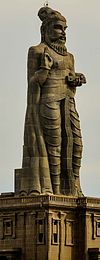Tirukkural translations into Japanese
| Part of a series on |
| Translation |
|---|
 |
| Types |
| Theory |
| Technologies |
| Localization |
| Institutional |
| Related topics |
|
As of 2015, the Japanese language has two translations available of the Tirukkural.[1]
History[edit]
The first Japanese translation of the Kural text was made by Shuzo Matsunaga in 1981.[2][3][4] Work on the translation began in the 1970s when Matsunaga chanced upon a few translated lines from the original work. Through his pen-pal in India, he obtained guidance and a copy of an English translation of the work by George Uglow Pope.[5] Having completed the translation by 1980, he published it the next year when he also attended the 5th World Classical Tamil Conference in Madurai in 1981, where he presented his research essay on the Kural.[5] Matsunaga also translated it into Korean.[6]
The second translation of the work was made by Japanese Indologist Takanobu Takahashi in 1999, which was titled Thirukkural: Sacred Verses of Ancient Tamil (ティルックラル: ティルヴァッルヴァル=著 高橋孝信=訳). 南インドのタミル地方で,今もなお誰もが口にする1300余の箴言。6世紀頃につくられ,法・財・愛をテーマにインド的思考を結晶させた聖なる短詩 (ティルックラル) を,詳細な注釈で読み解く) and was published by Heibonsha, Tokyo.[2]
Legacy[edit]
The first Japanese translation of the Kural, which was made with the guidance of S. M. Muthu, an Indian scholar of Tamil, eventually led to the Japanese government felicitating him for his services to Japanese literature by issuing commemorative stamps bearing his picture in 2007.[3][5] From the 50 odd letters through which Shuzo Matsunaga corresponded with Muthu during the translation work, Shuzo went on to publish his learning about the Indian culture in a book titled My India As Seen Through Letters.[3][5]
See also[edit]
References[edit]
- ^ Pallu, Nelza Mara; Mohanty, Panchanan; Durga, Shiva (May 2023). "Thirukkural Translations: A Sacred Text From the Town of Peacocks—Mayilâpûr India" (PDF). International Journal of Development Research. 13 (5): 62551–62553. doi:10.37118/ijdr.26323.05.2023 (inactive 31 January 2024). ISSN 2230-9926. Retrieved 18 November 2023.
{{cite journal}}: CS1 maint: DOI inactive as of January 2024 (link) - ^ a b Polilan; K. Gunathogai; Lena Kumar; Tagadur Sampath; Mutthamizh; G. Picchai Vallinayagam; D. Anbunidhi; K. V. Neduncheraladhan, eds. (2019). Tiruvalluvar 2050 (in Tamil) (1 ed.). Chennai: Periyar Enthusiasts Group. p. 686.
- ^ a b c Kannadasan, Akila (24 June 2012). "Friendship that has withstood time". The Hindu. Coimbatore: Kasturi & Sons. Retrieved 4 January 2018.
- ^ Saqaf, Syed Muthahar (31 March 2016). "Tamil scholar passes away". The Hindu. Salem: Kasturi & Sons. Retrieved 4 January 2018.
- ^ a b c d Bhaskar, Sailendra (16–31 May 2016). "The Indian on a Japanese stamp". Madras Musings. XXVI (3). Retrieved 4 January 2018.
- ^ Padmanabhan, S. (2000). Thiruvalluvar, a universal poet (Released on the occasion of unveiling of the 133-feet high statue of the immortal bard Thiruvalluvar). Nagecoil, India: Kanyakumari Historical and Cultural Research Centre. pp. 60 pages.
External links[edit]
- Ashraf, N. V. K. (October 2005). "Tiruvalluvar and Tirukkural: 提鲁克鲁经, 印度教手稿". GeoCities. Retrieved 16 April 2017.

